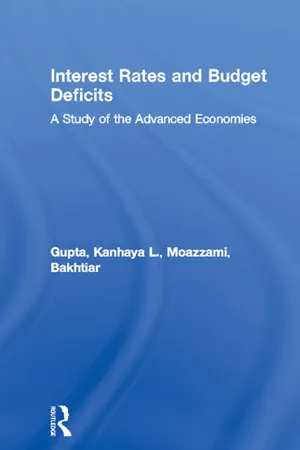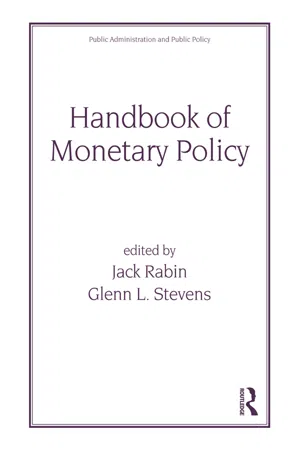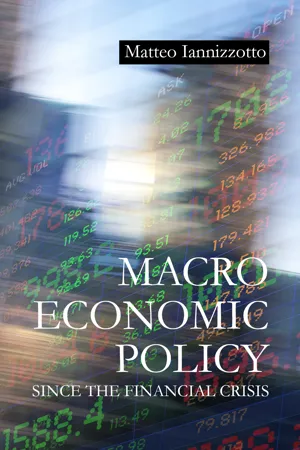Economics
Fisher Effect
The Fisher Effect is an economic theory that describes the relationship between nominal interest rates, real interest rates, and inflation. It suggests that nominal interest rates adjust in response to changes in expected inflation, with the real interest rate remaining relatively constant. In essence, the Fisher Effect posits that nominal interest rates move in tandem with changes in expected inflation to maintain a stable real interest rate.
Written by Perlego with AI-assistance
Related key terms
Related key terms
1 of 4
Related key terms
1 of 3
5 Key excerpts on "Fisher Effect"
- eBook - ePub
- Kanhaya L. Gupta, Bakhtiar Moazzami(Authors)
- 2005(Publication Date)
- Routledge(Publisher)
4 INTEREST RATES, INFLATION AND TAXES
One of the most popular but controversial issues in the literature relating to interest rates is the relationship between expected inflation and interest rates. This relationship was first articulated by Fisher (1930) in a concrete form. Briefly, this states that in the long run, nominal interest rates will change one-for-one for a given change in expected inflation. This prediction, however, holds only when there are no taxes. This prediction is changed to a greater than unity effect once taxes on interest income are included (see Darby (1975) and Feldstein (1976)).There have been numerous attempts to test the Fisher Effect.1 But still there is no general support for its validity either across time for a given country or across different countries for the given time period (Mishkin, 1984). While we do not expect to settle this issue, nevertheless we present the most extensive evidence on this hypothesis as yet available. This is done using the most recent techniques available for analysing time series data.THE MODEL AND THE METHODOLOGY
The Fisher hypothesis postulates that in the long run a rise in the expected rate of inflation will lead to an equivalent rise in the nominal interest rate:whereitis the nominal interest rate at time t , is the expected rate of inflation at timet, Reis the ex-ante real rate of interest andutis a stochastic disturbance term. If taxes are ignored, the Fisher hypothesis can be tested by testing whether the coefficient of the expected rate of inflation is identical to unity. Estimating the Fisher equation in the form presented in (1) suggests that we are continuously on the long-run steady-state equilibrium path and that there is no deviation from this long-run equilibrium path in the short run. A common characteristic of the estimated results reported for equation (1) is a low Durbin-Watson statistic which can be regarded as a manifestation of specification error due to the omission of the short-run dynamics. Most researchers have dealt with this problem by using the Cochrane-Orcutt procedure which corrects for the presence of first-order autocorrelation in the disturbance term.2 - eBook - ePub
- Jack Rabin(Author)
- 2020(Publication Date)
- Routledge(Publisher)
4 As indicated before, the federal funds rate is used as a measure of the stance of monetary policy. Thus a monetary policy action is defined as a change in the funds rate, and a monetary policy strategy is defined as the reaction function that would lead to policy actions. The Fisher relation for interest rates provides a convenient framework within which effects of policy actions can be described. The Fisher relation is(1)BR t= rr t e+,p ˙t ewhere BRtis the bond rate,ris the expected long real rate, andr t eis the expected long-term inflation rate. Equation (1) relates the bond rate to expectations of inflation and the real rate.p ˙t eThe Fisher relation indicates that policy actions could conceivably affect the bond rate by altering expectations of inflation, the real rate, or both. Since policy actions may not always move the real rate and inflation components in the same direction, the near-term responses of the bond rate to such actions cannot be determined a priori. Much may depend upon the nature of the strategy being pursued by the Fed. Goodfriend (1993) discusses three different strategies that may lie at the source of interaction between the bond rate and the funds rate. Consider, first, pure cyclical strategies in which the Fed routinely raises (lowers) the funds rate in response to cyclical expansions (downturns) without attempting to affect the current trend rate of inflation expected by the public. Under that strategy, a funds rate increase will tend to raise the bond rate by raising current and expected future short real rates (i.e., by raising thercomponent in [1]). This cyclical comovement is short run in nature.r t eThe second strategy discussed by Goodfriend considers the response of the Fed to an exogenous change in the trend rate of inflation. If the trend rate of inflation increases, the bond rate automatically moves with inflation (equation [1]). The Fed may choose to keep the short real rate steady and will therefore move the funds rate in line with the rising or falling inflation rate. In this case the bond rate comoves with the funds rate because the Fed is responding to changing inflation in a neutral fashion. I refer to this source of comovement as long run in nature. - eBook - ePub
- Matteo Iannizzotto(Author)
- 2023(Publication Date)
- Agenda Publishing(Publisher)
1936 ) and was therefore unavoidable. The problem is therefore that the interest rate measured on the vertical axis of all IS-LM diagrams would need to be the real one for the IS curve and the nominal one for the LM. In practice putting the two curves together in a single diagram blurs this distinction.The two definitions of the interest rate are related by the Fisher relationship but they cannot be considered identical and depend on what the expected rate of inflation is (πe). This can be done as follows. The gross3 real interest rate can be defined as the ratio of the (gross) nominal rate divided by the (gross) expected rate of inflation:The reason why the expected rate of inflation has to be taken into account is because the earning of interest involves the passage of time, during which obviously prices may vary in ways that are unknown at the moment of making the investment decision.4 Some simple manipulation can translate the above into the following:This last statement is the Fisher relationship and it holds as an approximation in that the term (rπe - eBook - ePub
- R. Stafford Johnson(Author)
- 2010(Publication Date)
- Wiley(Publisher)
Fisher Effect, after Irving Fisher, the economist who broached this relation. The Fisher Effect is helpful in explaining not just the relatively high interest rate periods of the late 1970s when the U.S. inflation rate was relatively high, but also low interest rate periods when inflation expectations are low. For example, in the late 1990s, Japan experienced very low interest rates and deflation, with Treasury rates actually becoming slightly negative in 1998. Using our analysis, on the bond supply side, expected deflation (often combined with recession) decreases the bond supply, whereas on the demand side, the expected deflation increases bond demand. Together the demand and supply response to expected deflation would increase the price of bonds and lower their rate.Interest Rate Expectations and Liquidity
Expectations about future interest rate levels and bond liquidity relative to the liquidity of other investments are two other factors affecting the demand and supply for bonds. However, interest rate expectations and liquidity tend to impact the relative demands and supplies of different types of bonds rather than the relative supplies and demands between the broader equity and debt security classes. As a result, interest rate expectations and liquidity are better explained in terms of the structure of rates than the level of rates. For example, a market expectation of higher interest rates in the future would likely lead to lower bond demand for intermediate and long-term bonds, and a greater demand for short-term bonds. Thus, interest rate expectations are more likely to lead to substitutions between bonds with different maturities, than between and aggregate bonds and equity groups.Combined Effects The aggregate bond supply and demand model is a partial equilibrium analysis that can be used to explain the impacts of a change in a specific exogenous economics factor with other determining factors assumed constant. Extending this methodology to understand past or future interest rate levels requires identifying all of the important factors influencing rates. Consider two of the most dramatic interest rate periods: the late 1970s and early 1980s, when interest rates were at an unprecedented high level, and more recently in 2008 when rates were at a very low level. It can be argued that the high interest rates of the late 1970s and early 1980s were the result of the period’s high inflation rate that averaged over 10% and the contractionary monetary policy undertaken by the Federal Reserve. In contrast, it can be argued that the low rates on securities in 2008 were caused by the slowdown in the world economy and the aggressive expansionary monetary actions of the Fed and other central banks (see Exhibit 3.1 - eBook - ePub
- INTERNATIONAL MONETARY FUND(Author)
- 1984(Publication Date)
- INTERNATIONAL MONETARY FUND(Publisher)
Second, it clearly shows that the measured impact on interest rates of all explanatory variables is conditional on the tax rate, τ. Since that rate may vary over time, it suggests a reason for changes over time in the fit of many interest rate equations. Finally, the derivation of equation (10) makes clear the theoretical basis for a negative relationship between expected inflation and the expected after-tax real rate. 13 The impact of expected inflation on the nominal interest rate reflects a combination of four factors: (1) the Fisher Effect, whereby the nominal interest rate rises by the full amount of a rise in expected inflation; (2) the tax effect, whereby the nominal interest rate must rise by more than the rise in expected inflation to maintain a constant expected after-tax real return; (3) the Mundell-Tobin effect, captured in equations (7) and (8), whereby a rise in expected inflation decreases equilibrium real cash balances, in turn increasing the steady-state level of flow savings owing to the real balance effect, with equilibrium being restored by means of a lower after-tax real interest rate, which raises investment to the higher level of savings; and (4) the Feldstein-Summers effect, whereby a rise in anticipated inflation depresses expected after-tax profits and causes investment to fall. In sum, tax effects move the coefficient above unity, while the Mundell effect and the Feldstein-Summers effect both push it below unity. Typical parameter values for τ and λ 1 indicate an expected value of 0.75 for the coefficient describing the impact of expected inflation on the nominal interest rate. 14 Even though tax effects by themselves tend to push the coefficient above unity, the combined depressing impact of the Mundell effect and the Feldstein-Summers effect may result in a net impact below unity
Index pages curate the most relevant extracts from our library of academic textbooks. They’ve been created using an in-house natural language model (NLM), each adding context and meaning to key research topics.
Explore more topic indexes
Explore more topic indexes
1 of 6
Explore more topic indexes
1 of 4




